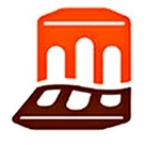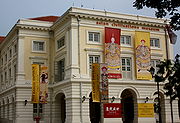
Asian Civilisations Museum
Encyclopedia
The Asian Civilisations Museum (ACM) is an institution which forms a part of the three museum
s of the National Museum of Singapore
. It is one of the pioneering museums in the region to specialise in pan-Asia
n cultures and civilisations. The museum specialises in the material history of China
, Southeast Asia
, South Asia
and West Asia, from which the diverse ethnic groups of Singapore trace their ancestry.
building on 22 April 1997 at Armenian Street, with exhibits largely centred on Chinese civilisation. With the restoration of the Empress Place Building
, the museum established its new flagship museum there on 2 March 2003, rapidly expanding the collection to other areas of Asia. The Armenian Street branch closed for renovations on 1 January 2006 and reopened on 25 April 2008 as the Peranakan Museum
, specialising in Peranakan
culture.
On September 16, 2006, the Museum officially launched its new logo with a new slogan The Asian Civilisations Museum - Where Asian Cultures Come Alive!. This new logo reflects the museum's unique location by the historic Singapore River, the source and origin of Singapore multi-cultural society, which the ACM presents in its collection. The brown reflected image also alludes to the museum as a place for reflection, while the vibrant orange is an invigorating colour which represents activity and energy.

 The Chinese collection is represented by fine Dehua porcelain figures, Taoist and Buddhistic statuary, export porcelain, calligraphy and other examples of decorative art.
The Chinese collection is represented by fine Dehua porcelain figures, Taoist and Buddhistic statuary, export porcelain, calligraphy and other examples of decorative art.
The South Asian Galleries feature statuary from a broad spectrum of periods including some fine Chola bronzes. Of particularly note is the Chola bronze sculpture of Uma, the consort of Shiva and that of Somaskanda. The early Buddhist art of India is also represented by works hailing from the Mathura and Gandhara schools. The red sandstone Mathura Buddha of the museum's collection dated to the Kanishka era is rare and masterful work. Other areas of note include South Indian woodwork, Nepali-Tibetan bronzes, textiles, late medieval miniatures and colonial prints.
The Southeast Asian collections are broad in scope and are rich in ethnological material. Representing the aristocratic art of ancient Southeast Asia are Khmer sculptures, Javanese temple sculpture (some on loan from Leiden), later Buddhist art from Burma/ Thailand and the Sinicised temple art of Vietnam. Peranakan gold, textiles, tribal ornament and theatrical masks are other strengths of the collection.
Certain gallery rooms are also used for temporary exhibitions. A recent exhibition included the display of the spectacular bronze age masks from Sanxingdui, Sichuan Province, China.
Treasury of the World: Jewelled Arts of India in the Age of the Mughals
The Egawa Donation: A Collection of Japanese and Chinese Inspired Ceramics
2009
Land of the Morning: The Philippines and its People
Seeing The Invisible: An Insight to Conservation
The Kangxi Emperor: Treasures from the Forbidden City
Fantastic Creatures!
Neither East Nor West: Asians in Monochrome
Seeing Red: Propaganda and Material Culture in China (1966 – 1976)
Hunters and Collectors: The Origins of the Southeast Asian Collection
The Unguarded Moment by Steve McCurry
2008
Neither East Nor West: Asians in Monochrome
Seeing Red: Propaganda and Material Culture in China (1966 – 1976)
Viet Nam! From Myth To Modernity
2007
Many Traditions, One Strand – Textiles of the ASEAN Countries
On The Nalanda Trail: Buddhism in India, China and Southeast Asia
Chinese Snuff Bottles from the Sanctum of Enlightened Respect III
Beauty in Asia: 200 BCE to Today
Trade Ceramics in Southeast Asia
Mystery Men: Finds from China's Lost Age
2006
The Xiang Xue Zhuang Collection: Latest Donations to the Asian Civilisations Museum
Mobile Homes: Tents and Shelters for People on the Move
Hidden Faces: The Art of Japanese Masks
2005
Power Dressing: Textiles for Rulers and Priests from the Chris Hall Collection
Museum
A museum is an institution that cares for a collection of artifacts and other objects of scientific, artistic, cultural, or historical importance and makes them available for public viewing through exhibits that may be permanent or temporary. Most large museums are located in major cities...
s of the National Museum of Singapore
National Museum of Singapore
The National Museum of Singapore is a national museum in Singapore and the oldest museum in Singapore. Its history dates back to 1849 when it was started as a section of a library at Singapore Institution...
. It is one of the pioneering museums in the region to specialise in pan-Asia
Asia
Asia is the world's largest and most populous continent, located primarily in the eastern and northern hemispheres. It covers 8.7% of the Earth's total surface area and with approximately 3.879 billion people, it hosts 60% of the world's current human population...
n cultures and civilisations. The museum specialises in the material history of China
China
Chinese civilization may refer to:* China for more general discussion of the country.* Chinese culture* Greater China, the transnational community of ethnic Chinese.* History of China* Sinosphere, the area historically affected by Chinese culture...
, Southeast Asia
Southeast Asia
Southeast Asia, South-East Asia, South East Asia or Southeastern Asia is a subregion of Asia, consisting of the countries that are geographically south of China, east of India, west of New Guinea and north of Australia. The region lies on the intersection of geological plates, with heavy seismic...
, South Asia
South Asia
South Asia, also known as Southern Asia, is the southern region of the Asian continent, which comprises the sub-Himalayan countries and, for some authorities , also includes the adjoining countries to the west and the east...
and West Asia, from which the diverse ethnic groups of Singapore trace their ancestry.
History
The museum first opened its doors at the Old Tao Nan SchoolOld Tao Nan School
The Old Tao Nan School is a historic building in Singapore, located along Armenian Street in the Museum Planning Area, within the Central Area in Singapore's central business district. The building was a wing of the Asian Civilisations Museum. The other wing of the museum is located at the Empress...
building on 22 April 1997 at Armenian Street, with exhibits largely centred on Chinese civilisation. With the restoration of the Empress Place Building
Empress Place Building
The Empress Place Building is a historic building in Singapore, located on the north bank of the Singapore River in the Downtown Core, within the Central Area in Singapore's central business district. The building is currently the second wing of the Asian Civilisations Museum...
, the museum established its new flagship museum there on 2 March 2003, rapidly expanding the collection to other areas of Asia. The Armenian Street branch closed for renovations on 1 January 2006 and reopened on 25 April 2008 as the Peranakan Museum
Peranakan Museum
The Peranakan Museum is a museum in Singapore specialising in Peranakan culture. A sister museum to the Asian Civilizations Museum, it is the first of its kind in the world, that explore Peranakan cultures in Singapore and other former Straits Settlements in Malacca and Penang, and other Peranakan...
, specialising in Peranakan
Peranakan
Peranakan Chinese and Baba-Nyonya are terms used for the descendants of late 15th and 16th-century Chinese immigrants to the Indonesian archipelago of Nusantara during the Colonial era....
culture.
On September 16, 2006, the Museum officially launched its new logo with a new slogan The Asian Civilisations Museum - Where Asian Cultures Come Alive!. This new logo reflects the museum's unique location by the historic Singapore River, the source and origin of Singapore multi-cultural society, which the ACM presents in its collection. The brown reflected image also alludes to the museum as a place for reflection, while the vibrant orange is an invigorating colour which represents activity and energy.

Collection highlights

The South Asian Galleries feature statuary from a broad spectrum of periods including some fine Chola bronzes. Of particularly note is the Chola bronze sculpture of Uma, the consort of Shiva and that of Somaskanda. The early Buddhist art of India is also represented by works hailing from the Mathura and Gandhara schools. The red sandstone Mathura Buddha of the museum's collection dated to the Kanishka era is rare and masterful work. Other areas of note include South Indian woodwork, Nepali-Tibetan bronzes, textiles, late medieval miniatures and colonial prints.
The Southeast Asian collections are broad in scope and are rich in ethnological material. Representing the aristocratic art of ancient Southeast Asia are Khmer sculptures, Javanese temple sculpture (some on loan from Leiden), later Buddhist art from Burma/ Thailand and the Sinicised temple art of Vietnam. Peranakan gold, textiles, tribal ornament and theatrical masks are other strengths of the collection.
Certain gallery rooms are also used for temporary exhibitions. A recent exhibition included the display of the spectacular bronze age masks from Sanxingdui, Sichuan Province, China.
Past exhibitions
2010Treasury of the World: Jewelled Arts of India in the Age of the Mughals
The Egawa Donation: A Collection of Japanese and Chinese Inspired Ceramics
2009
Land of the Morning: The Philippines and its People
Seeing The Invisible: An Insight to Conservation
The Kangxi Emperor: Treasures from the Forbidden City
Fantastic Creatures!
Neither East Nor West: Asians in Monochrome
Seeing Red: Propaganda and Material Culture in China (1966 – 1976)
Hunters and Collectors: The Origins of the Southeast Asian Collection
The Unguarded Moment by Steve McCurry
2008
Neither East Nor West: Asians in Monochrome
Seeing Red: Propaganda and Material Culture in China (1966 – 1976)
Viet Nam! From Myth To Modernity
2007
Many Traditions, One Strand – Textiles of the ASEAN Countries
On The Nalanda Trail: Buddhism in India, China and Southeast Asia
Chinese Snuff Bottles from the Sanctum of Enlightened Respect III
Beauty in Asia: 200 BCE to Today
Trade Ceramics in Southeast Asia
Mystery Men: Finds from China's Lost Age
2006
The Xiang Xue Zhuang Collection: Latest Donations to the Asian Civilisations Museum
Mobile Homes: Tents and Shelters for People on the Move
Hidden Faces: The Art of Japanese Masks
2005
Power Dressing: Textiles for Rulers and Priests from the Chris Hall Collection

